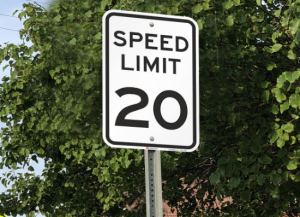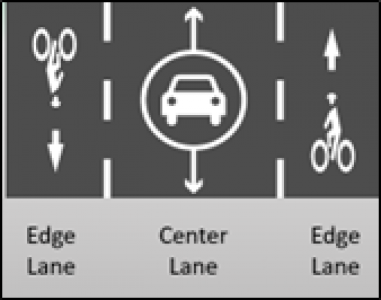What are Edge Lane Roads (ELRs)?
Edge Lane Roads (ELRs) are being implemented in Port Townsend to help make our small, neighborhood roadways safer for everyone. The goal of ELRs is to improve driver attention and slow cars. They replicate one lane roads which often encourage people to slow down. Port Townsend is on the forefront of slow streets innovation that is reflected in our community values like safety, fostering neighborhood connections, encouraging non-motorized transportation, and sharing the road. Aside from potholes, traffic calming is a top concern the City hears from residents.
Why are ELRs a good option for our neighborhood streets?
In many Port Townsend neighborhoods there are no sidewalks and the streets are narrow, creating a safety issue for pedestrians and people on bikes. When people use these roads as thoroughfares, or drive too fast on them, our Public Works team responds to neighborhood requests for traffic calming. When requests for safer, slower streets come in, our team spends time with community members engaging in productive dialogue about their concerns to determine the best approach. This process involves evaluating solutions recognizing resources are limited and traffic calming solutions are highly dependent on the location and how drivers perceive the road.
ELRs are one solution to safe, slow streets.
In order to ensure they are the right fit for a particular streetscape, the engineering and streets crew does extensive measurements of all the corners and hill crests to ensure there is adequate site distance. Uniquely, it is the curves and hills that make ELRs work well as a slowing measure because it changes driver perception of the street. In general, large and open streets create a feeling of comfort inducing high speeds. Once ELRs are striped, the speed limit in that area is also lowered to 20 mph. Motorist to pedestrian accident severity is greatly reduced at speeds of 20 mph or less, and thus, the goal is to reduce speeds significantly.

As an additional benefit, ELRs are cost-effective in that they slow down most drivers with fewer resources than other, more costly, traffic calming solutions. Keeping Port Townsend streets narrow lowers the tax burden on residents for paving and upkeep, as well as reduces the amount of impervious area and maximizes green space. Most cities have very large streets. ELRs help us keep our small and narrow streets. ELRs also keep vehicle tires from breaking the edge of the pavement by keeping cars more centered in the street.
They look like this:

ELRs are originally an European striping pattern. Here is an example:

ELR Design Guide, courtesy of www.advisorybikelanes.com
How do ELRs work?
Motorists use the center lane, and when passing an oncoming vehicle, they move temporarily into the edge lanes. This is done while yielding to bikes and pedestrians that may be in the edge lane. Once the motorized vehicles have gone around each other, they proceed by moving back into the center lane.

ELR Design Guide, courtesy of www.advisorybikelanes.com and Courtesy of the 2016 FHWA Small Town & Rural Multimodal Networks Guide.
While ELRs are new for our community, they are intuitive for Port Townsend given the many one-lane streets that are already in the city. An ELR is driven the same way when passing a pedestrian or a bike as on a one-lane street. Cars always need to yield to the pedestrian and bicyclist first no matter how the street is striped. ELRs simply create the expectation of watching for pedestrians and bikes in providing equity for all users of the streets we all rely upon. Since ELRs are new, engineering crews will be monitoring speed data after each installation, as well as driver behavior. In the neighborhoods where we have implemented ELRs we are seeing much improved results.
thanks for your commitment to watching out for one another and being safe on the roads!
FAQs
What is the speed limit when driving an ELR in Port Townsend?
20 mph
Is there data behind ELRs effectiveness?
The primary intent of installing ELRs is to increase safety for all street users. Motorists tend to drive more slowly in ELRs which in turn increases safety for all. Studies from 11 US cities over 8 years and 60 million vehicle trips showed a 44% overall reduction in crashes compared to previously existing 2-lane configurations. (Mineta Institute. Safety Considerations for All Road Users on Edge Lane Roads. 2022)
What are some of the benefits of installing ELRs?
- Reduces Speeds: Visually narrows the street, which in turn slows drivers down.
- Safer Passing: Motor vehicles leave more space between themselves and the bicyclists/pedestrians they pass, since there is no centerline.
- Organizes modes: ELRs clearly indicate where bikes and pedestrians should be in relation to both parked and moving motor vehicles.
- Installation costs less: ELRs provide bike and pedestrian facilities without adding shoulders or concrete sidewalks.
- Increases pavement life: Motor vehicles do not drive on the edge of the pavement, which helps the street surface last longer.
Additional resources:
Videos:
- In Portland (2:45 minutes): https://www.youtube.com/watch?v=51o7hCKJZLg
- Conceptual (Swedish – 31 seconds): Https://youtu.be/4smg1uDY-OQ
- In the Netherlands (29 seconds): https://www.youtube.com/watch?v=MzFPl94pXy0
- City Of Port Townsend Streets Video
Advisory Bike Lanes:
https://www.advisorybikelanes.com/
https://www.advisorybikelanes.com/more-info.html
City presentations:
March 2,2022:
https://cityofpt.granicus.com/player/clip/2375?view_id=4&redirect=true (starting at about 40:20 minutes) – pdf of presentation also attached to the meeting agenda.
May 4, 2022:
https://cityofpt.granicus.com/player/clip/2405?view_id=4&redirect=true (starting at about 4:30 minutes) – pdf of presentation also attached to the meeting agenda.
July 5, 2022:
https://cityofpt.granicus.com/player/clip/2439?view_id=4&redirect=true (starting at about 1:16:05 hour/minutes) – pdf of presentation also attached to the meeting agenda.
April 27, 2023:
Presentation to the American Public Works Association (APWA) in Tacoma, Washington

